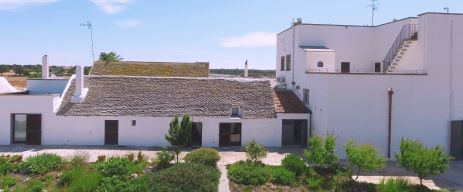estate

Donna Coletta is one of the many farmhouses scattered over the territory of Noci It is located on top of a hill and it is the center of a farm of 20 hectares of grazyland. It consists of two buildings – the oldest, which was erected in the 18th century and which has got a roof in the shape of a "pignon", and the second which was erected in the following century, in cubic shape.This building was the master's residence.
We learn from the institutional website of Noci that the farm houses scattered over the 15,000 hectares od Noci farmland were authentic architectonic emergences and they demonstrate the process of anthropization of the territory.
The succeeding stages of transformation which occurred to these agricolrural structures over the centuries are interesting.
Also interesting is the development of management of the whole rural farmhouse complex.
The earliest cockpits in the shape of trulli, and the "casedde" (small houses) turned over the years into haystacks and barns for convenience in so as to make the countryside life more autonomous from town life.

As the country workers found very tiring to cover hours of hard walk to their residence from the place of work, small farmhouses were settle already in the 18th century and provided dwellings for "ualani" and chapels for the celebration of the Sunday Mass. Structural characteristic of the farmhouse were the "iazzi" The courts, the cortaglie (corrals for the cattle) built in dry stone walls, and the "parieti" erected as well in dry stone walls in order to collect rain waters, and finally "the tracts ( country lanes )" for the traffic of carts and cattle.
In the wake of the Unity of Italy, many farms from simple service facilities were refurbished and expanded by radical constructions.
Graced with special architectural changes the farmhouse turned into prestigious summer homes for the owners who lived in the city center . This is the period of greatest development for the farmhouses of Noci and unfortunately it coincided with the start of the territory transformation. In fact the extensive woodland characteristic of the territory (to recall the "Bonelli's forest), considered up to the Unity of Italy the largest woodland in the Bari Province) gave way to arable land even in support of space intended for the cattle. The remaining woodland areas however, even less extensive than in the past continue to make our hills green and give out salutary oxygen

